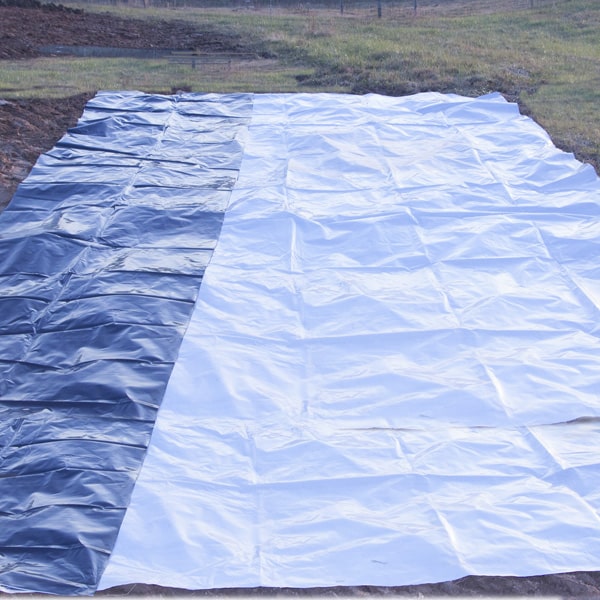Silage Tarps
Silage tarps can be employed as a preventive measure to suppress weed growth before planting crops. By covering the soil for an extended period—typically several weeks to months—prior to planting, weed seeds are deprived of the light and moisture necessary for germination and growth. This effectively reduces the weed seed bank in the soil and minimizes the need for post-emergence weed control methods.
Key benefits:
- Smothering effect: When laid over the soil surface, silage tarps act as physical barriers that block sunlight from reaching weed seeds and seedlings underneath. The lack of sunlight prevents photosynthesis, inhibiting the growth of weeds and causing them to die off.
- Reduction of weed pressure: By effectively suppressing weed growth, silage tarps reduce weed pressure in agricultural fields, resulting in fewer weeds competing with crops for resources such as water, nutrients, and sunlight. This can lead to improved crop establishment, growth, and yield, as well as reduced labor and input costs associated with weed management.
- Non-chemical approach: The use of silage tarps for weed control offers a chemical-free alternative to traditional herbicide applications. They provide a natural and environmentally friendly method of weed suppression without introducing chemical residues into the soil or surrounding ecosystem.
- Soil improvement: In addition to weed control, silage tarps can contribute to soil improvement by promoting soil moisture retention, temperature regulation, and microbial activity. The absence of weed competition allows soil microorganisms to thrive, leading to enhanced nutrient cycling and soil structure. Over time, the decomposition of weed residues under the silage tarps adds organic matter to the soil, further enriching its fertility and tilth.
- Integration with crop rotation: Silage tarps can be integrated into crop rotation systems to suppress weeds between cash crop plantings. After harvesting a cash crop, silage tarps can be laid over the soil surface to suppress weed growth and prepare the field for the subsequent crop rotation cycle. This helps maintain soil health and reduce weed pressure over time, contributing to sustainable and regenerative agriculture practices.
Contact Berry Hill Irrigation Specialists to learn more.
Results
Silage tarps can be employed as a preventive measure to suppress weed growth before planting crops. By covering the soil for an extended period—typically several weeks to months—prior to planting, weed seeds are deprived of the light and moisture necessary for germination and growth. This effectively reduces the weed seed bank in the soil and minimizes the need for post-emergence weed control methods.
Key benefits:
- Smothering effect: When laid over the soil surface, silage tarps act as physical barriers that block sunlight from reaching weed seeds and seedlings underneath. The lack of sunlight prevents photosynthesis, inhibiting the growth of weeds and causing them to die off.
- Reduction of weed pressure: By effectively suppressing weed growth, silage tarps reduce weed pressure in agricultural fields, resulting in fewer weeds competing with crops for resources such as water, nutrients, and sunlight. This can lead to improved crop establishment, growth, and yield, as well as reduced labor and input costs associated with weed management.
- Non-chemical approach: The use of silage tarps for weed control offers a chemical-free alternative to traditional herbicide applications. They provide a natural and environmentally friendly method of weed suppression without introducing chemical residues into the soil or surrounding ecosystem.
- Soil improvement: In addition to weed control, silage tarps can contribute to soil improvement by promoting soil moisture retention, temperature regulation, and microbial activity. The absence of weed competition allows soil microorganisms to thrive, leading to enhanced nutrient cycling and soil structure. Over time, the decomposition of weed residues under the silage tarps adds organic matter to the soil, further enriching its fertility and tilth.
- Integration with crop rotation: Silage tarps can be integrated into crop rotation systems to suppress weeds between cash crop plantings. After harvesting a cash crop, silage tarps can be laid over the soil surface to suppress weed growth and prepare the field for the subsequent crop rotation cycle. This helps maintain soil health and reduce weed pressure over time, contributing to sustainable and regenerative agriculture practices.
Contact Berry Hill Irrigation Specialists to learn more.

$175.00 – $310.00

